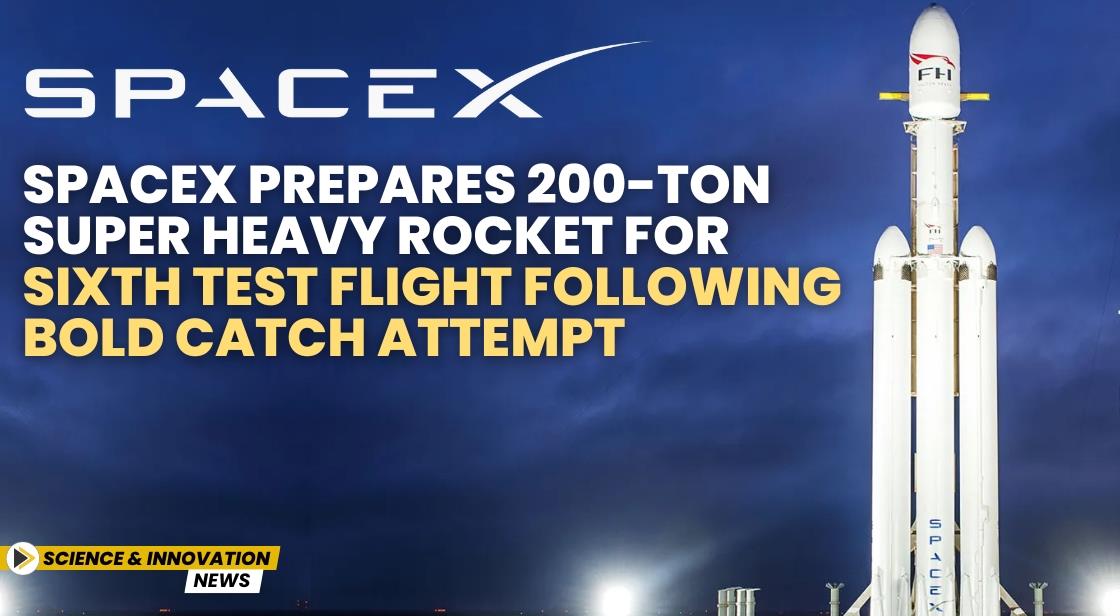SpaceX Prepares 200-Ton Super Heavy Rocket for Sixth Test Flight Following Bold Catch Attempt

News Synopsis
In an impressive display of efficiency and technological advancement, SpaceX has moved the Super Heavy booster intended for Starship's sixth test flight to the launch pad at Starbase, Texas. This booster, known as Booster 13, is set to undergo a series of crucial pre-flight tests before its scheduled launch, marking yet another important milestone in the development of the Starship program. The swift relocation of the booster, coming just one week after a historic catch of the previous Super Heavy booster, emphasizes SpaceX’s commitment to accelerating the testing and development phases of its ambitious Starship project.
Rapid Turnaround After Historic Catch
The recent move of Booster 13 to the launch pad follows a significant achievement in SpaceX's reusable rocket technology. In the previous test flight, SpaceX successfully caught and returned a Super Heavy booster using the mechanical arms of its launch tower, a feat often referred to as the "chopsticks" catch mechanism. This marked the first time in history that such a recovery method had been successfully demonstrated.
The ability to catch and quickly redeploy Super Heavy boosters is essential to SpaceX’s vision of rapid reusability, which aims to reduce the time and costs associated with launching large rockets. The quick turnaround time between the catch of the last booster and the preparation of Booster 13 underscores the company's growing efficiency in managing its Starship fleet.
Pre-Flight Testing at Starbase
Upon arriving at Starbase, Booster 13 was mounted on the orbital launch platform to undergo a series of critical pre-flight tests. These tests are designed to ensure the rocket’s readiness for its sixth flight test and include cryogenic proof testing and static fire engine tests.
Cryogenic proof tests involve filling the rocket with super-cold liquid nitrogen to verify the integrity of its fuel tanks and plumbing, ensuring that the booster can handle the extreme conditions it will face during launch. Static fire tests, on the other hand, involve igniting the booster’s engines while the vehicle remains stationary on the pad. These tests provide vital data about the performance of the engines and overall system, confirming that everything is functioning as expected before launch day.
These pre-flight tests are a critical part of SpaceX’s development process, allowing engineers to refine and improve the vehicle's design based on real-world data. SpaceX has always been known for its “test, fail, learn, and iterate” approach, and each test provides valuable insights that can be applied to future missions.
Refining the Booster Catch Mechanism
One of the most groundbreaking aspects of SpaceX’s Starship program is its focus on making rockets fully reusable. The company aims to achieve this by catching and reusing the Super Heavy booster, which serves as the first stage of the Starship system. During the previous test flight, SpaceX successfully demonstrated its innovative booster catch system, in which mechanical arms on the launch tower (dubbed "chopsticks") capture the booster mid-air after launch.
The upcoming sixth flight test is expected to build upon this success, with engineers continuing to refine the catch mechanism. While the catch process worked well during the previous flight, there is always room for improvement. SpaceX is likely to make adjustments to ensure that future booster recoveries are even more efficient and reliable.
There has also been speculation that SpaceX might attempt to catch the Starship upper stage in future missions, although this has not yet been officially confirmed. If successful, this would represent another huge leap forward in the company’s mission to develop fully reusable rockets.
SpaceX’s Ambitious Vision for Starship
SpaceX's progress with the Starship program has not only caught the attention of the global space industry but also NASA. The space agency is closely watching Starship's development, particularly because the vehicle has been selected to serve as the Human Landing System (HLS) for NASA's Artemis missions. These missions aim to return humans to the Moon, with Starship playing a key role in landing astronauts on the lunar surface.
NASA’s interest in the program highlights the broader implications of SpaceX’s work. Starship is not just about improving rocket reusability; it has the potential to revolutionize space travel altogether. By reducing the cost of launches and enabling rapid reusability, SpaceX hopes to make deep space exploration more accessible. This would pave the way for ambitious missions, not only to the Moon but also to Mars and beyond.
Pushing Boundaries and Preparing for the Future
As SpaceX continues to push the boundaries of space technology, each new test flight brings the company closer to realizing its ultimate goal of making Starship a fully and rapidly reusable spacecraft. The sixth test flight of Booster 13 is expected to follow a similar mission profile to previous flights, but with additional refinements based on data gathered from earlier tests. By continuing to learn from each mission, SpaceX is rapidly iterating on its design and improving the performance of its rockets.
The upcoming test will likely include another demonstration of the booster catch mechanism, along with additional tests of the vehicle’s systems. SpaceX’s goal is not just to launch rockets more frequently but to develop a system that can be used repeatedly with minimal refurbishment between flights. Achieving this would significantly reduce the cost of space exploration and enable humanity to embark on more ambitious missions, such as colonizing Mars.
Conclusion
SpaceX’s rapid progress in developing the Starship system is a testament to its innovative approach and dedication to pushing the limits of space technology. With the recent success of its booster catch system and the preparation of Booster 13 for its sixth test flight, SpaceX is well on its way to achieving its vision of fully reusable rockets. As the company continues to refine its designs and build upon previous successes, the future of space travel looks brighter than ever. Each test flight brings SpaceX closer to making space exploration more affordable, accessible, and sustainable, ultimately enabling humans to venture further into the cosmos than ever before.
You May Like









